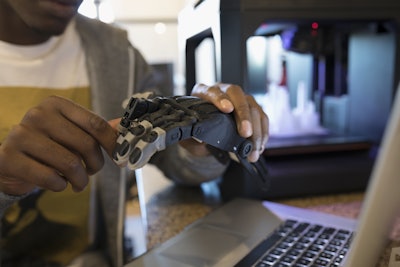
With increasing popularity of 3D printing, medical device manufacturers are focused on innovations. Substantial need for individualized yet economical medical solutions is met through 3D-printed medical devices. Complex features of integration such as hard and soft areas, solid and porous structures, multi-material and multi-color, which seemed to be difficult by implementing conventional manufacturing techniques, is made simpler through 3D printing.
These observations come from Future Market Insights’ revised forecast of the global 3D-printed medical devices market, which it forecasts to expand at a CAGR of 18.1% between 2017–2027. FMI says the increasing prevalence of chronic diseases and a rising awareness regarding personal care are major factors driving the growth of the 3D-printed medical devices market.
Orthopedics lead applications
The report segments the global 3D-printed medical devices market based on application, technology, material type, end user and region. On the basis of application, FMI breaks down the market into orthopedic Implants, dental implants and cranio-maxillofacial implants.
Orthopedic implants application segment accounted for a higher revenue share in global 3D printing devices as compared to others in application segment. Orthopedic implants segment in the application category of the global 3D-printed medical devices market was estimated to be valued at nearly $170 million in 2017 and is slated to reach a valuation of nearly $970 million by 2027, exhibiting a 19.2% CAGR.
Material type
Based on the material type, FMI divides the 3D-printed medical devices market into metals and alloys, biomaterial inks and plastics. The biomaterial inks segment was estimated to be valued at nearly $65 million in 2017, and is anticipated to reach nearly $400 million by 2027, showing 20% CAGR.
Hospitals the top end-user market
Based on the end user, 3D-printed medical devices market includes hospitals, ambulatory surgical centers and diagnostic centers. The hospital segment, says the report, accounts for higher demand for 3D printing devices, registering an 18.7 CAGR of 18.7% over the forecast period.
Global market forecasts
Globally, the 3D-printed medical devices market is segmented by FMI into North America, Latin America, Western Europe, Eastern Europe, Asia Pacific excluding Japan, Japan and the Middle East and Africa. Revenues in Western Europe are expected to grow at a CAGR of 18.6%, whereas Eastern Europe is anticipated to grow at 15.5% over the forecast period. Meanwhile, Western Europe’s market was estimated at nearly $65 million in 2017, with an expected rise to nearly $360 million by 2027. The Eastern Europe market was estimated at nearly $40 million in 2017, with forecasts of reaching nearly $ $160 million in 2027.



















